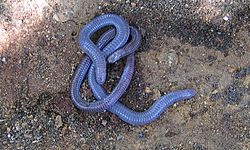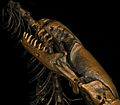Amphisbaenians facts for kids
Quick facts for kids Worm lizardsTemporal range: Cretaceous - Recent
|
|
|---|---|
 |
|
| A worm lizard | |
| Scientific classification | |
| Kingdom: | |
| Phylum: | |
| Class: | |
| Order: | |
| Suborder: |
Amphisbaenia
Gray, 1844
|
Amphisbaenia, often called worm lizards, are a fascinating group of reptiles. They are part of the Squamata order, which includes snakes and lizards. There are over 180 different kinds of worm lizards known today.
Worm lizards are known for their long, slender bodies. Most species do not have legs. Their eyes are very simple and often hidden. Many worm lizards have pink bodies and scales arranged in rings. This makes them look a lot like earthworms.
One special group, called Bipes, is unique. These worm lizards are the only ones that still have front legs. All other types of worm lizards are completely legless. Most worm lizards are quite small, usually less than 15 centimeters (6 inches) long.
Contents
What Makes Worm Lizards Special?
Worm lizards have many unique features. These features help tell them apart from other reptiles. For example, their right lung is smaller to fit their narrow bodies. In snakes, it is always the left lung that is smaller. Scientists believe worm lizards are most closely related to true lizards.
How Do Worm Lizards Move?
The skin of a worm lizard is not tightly attached to its body. This allows them to move in a very special way. They use an "accordion-like" motion. Their skin moves forward, and their body seems to slide along behind it. What's really cool is that they can move backward just as easily and quickly as they move forward! This is very unusual for animals.
What Do Worm Lizards Eat?
Worm lizards are carnivores. This means they eat other animals. They have strong, interlocking teeth. These teeth help them tear off pieces from larger prey. Like some lizards, certain worm lizard species can drop their tails if they are in danger. This is called autotomy. Most worm lizard species lay eggs.
Where Do Worm Lizards Live?
Worm lizards are found in many parts of the world. They live in North America, Europe, Africa, South America, Western Asia, and the Caribbean. This is a surprisingly large area for such small animals. They are subterranean, meaning they live underground. They rarely leave their burrows. You will not find them east of the Caspian Sea.
Images for kids
See also
 In Spanish: Amphisbaenia para niños
In Spanish: Amphisbaenia para niños



